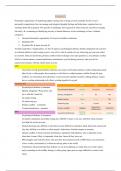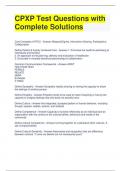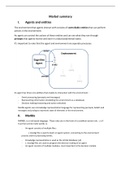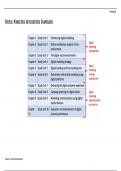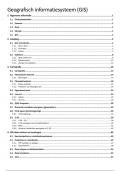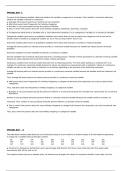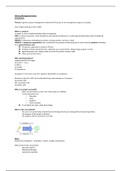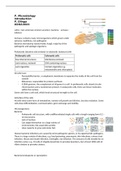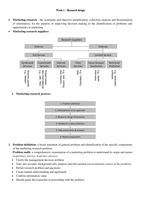Lecture 4
Personality organization à underlying adaptive doing well, to being severely mentally ill, this is one’s
personality organization, how me manage and integrate thoughts feelings and behaviours, captures how we
would go about life in general. Not specific to challenges, but in general to what extent are you able to navigate
life easily à a continuing to identifying severity of mental illnesses, on the continuing we have 3 distinct
categories:
1. Neurotic Personality organization à closest to healthier continuum
2. Borderline PO
3. Psychotic PO à more severely ill
To help visual these 3 organizations, we have 6 aspects: psychological defense, identity integration (do you have
on coherent identity), reality testing (you’re own self vs what is outside of you), observing ego (can you reflect
on yourself, what you do/moods), primary conflict (what in therapy your main question is, your primary conflict
will be of certain nature), counter/transference (transference you feel during sessions, what you feel in
contact/conversation, what the clients elicits in you).
NPO
- Good sense of self, good identify coherence one sense of self mature defense, reality testing intact good
idea of you vs other people, have capacity to self-observe, oedipal primary conflict (living life type
conflicts, not existential, more about how I can be myself, maintain myself), working alliance counter
have a working relationship with client, working together for a goal.
Psychotic PO
- Psychological defense is immature.
- Identity integration à big issue, who
am I, what do I stand for,
- No reality testing.
- No observing ego
- Primary conflict – existential
- Counter/transference – parental.
BPO
- Psychological defense à immature,
- no identity integration and reality testing are LARGELY intact, every now and then when emotions
rise high this can be an issue,
- limited observing ego, difficult to self-observe more difficult to mentalize, think about their actions and
why they did that or to reflect on other people’s behaviours, limited compare to neurotic,
- primary conflict is about closeness and distance, separation-individuation, who is important to me,
what does it mean if they’re important, what does I mean if they leave me,
- PPO struggles start with the client, who am I how do I position myself, in BPO there is an interaction
of me vs other, and neurotic it’s about me and my place in the world.
- Transference all good all bad, their defense we see more splitting, we really like you or don’t and is
rarely something in the middle, therapy is either going super great or super difficult to connect with
client.
, Personality disorders combinations: guide for therapeutic context
depending on primary conflict.
à NPO/cluster C, therapy give insight, less on weekly structure.
o Defenses mature (E.g. Humor, it doesn’t pretend
something isn’t there, denial affects reality more
and this will be considered more immature),
o identity integrated, reality testing intact, anxiety
about who we are, few existential questions.
à BPO, narcissism, BPD low level, BPD high level
o Primitive defense, diffused polarization, intact.
PPO/cluster A à supportive/structuring therapy
o defensive primitive, identity diffused no boundaries, reality testing compromised.
Id demand immediate gratification (e.g., wanting
to eat a whole cake).
Superego may dictate that such behaviour is wrong or
unhealthy (e.g., "You shouldn't eat that)
Ego mediates this conflict by finding a
compromise (e.g., having a small piece of
cake instead)
The dynamic interplay between the id, ego, and superego
creates internal conflict influencing behaviour and decisions.
Defense mechanisms: EXAM questions!
- Psychological strategies, unconsciously used, protect us or help us cope or sense of self/ego.
- Gender differences W internalize defense (frustrated), M externalizing defense (E.g. Acting out)
Mature defense mechanism à less research, less linked to pathology
- Help individuals deal with stressful experiences by integrating affects with ideas, optimizing resolution
of internal/external cause of stress.
- Internal/external stressors are fully perceived w/o distortion.
Humor Doesn’t distort reality, not saying I’m not nervous just joking about it, doesn’t disturb oneself.
Sublimation expressing a personally unacceptable feeling in a socially acceptive way, (joining a sports club art classes,
considered more adaptive defense mechanisms it can transform negative anxiety into positive energy,
expressing an internal need in an indirect way).
Suppression pushing an unpleasant feeling, thought or desire deliberate out of consciousness, attempts to not think about a
memory or feelings.
Altruism helping others to feel better about oneself, avoiding negative personal feelings.
Personality organization à underlying adaptive doing well, to being severely mentally ill, this is one’s
personality organization, how me manage and integrate thoughts feelings and behaviours, captures how we
would go about life in general. Not specific to challenges, but in general to what extent are you able to navigate
life easily à a continuing to identifying severity of mental illnesses, on the continuing we have 3 distinct
categories:
1. Neurotic Personality organization à closest to healthier continuum
2. Borderline PO
3. Psychotic PO à more severely ill
To help visual these 3 organizations, we have 6 aspects: psychological defense, identity integration (do you have
on coherent identity), reality testing (you’re own self vs what is outside of you), observing ego (can you reflect
on yourself, what you do/moods), primary conflict (what in therapy your main question is, your primary conflict
will be of certain nature), counter/transference (transference you feel during sessions, what you feel in
contact/conversation, what the clients elicits in you).
NPO
- Good sense of self, good identify coherence one sense of self mature defense, reality testing intact good
idea of you vs other people, have capacity to self-observe, oedipal primary conflict (living life type
conflicts, not existential, more about how I can be myself, maintain myself), working alliance counter
have a working relationship with client, working together for a goal.
Psychotic PO
- Psychological defense is immature.
- Identity integration à big issue, who
am I, what do I stand for,
- No reality testing.
- No observing ego
- Primary conflict – existential
- Counter/transference – parental.
BPO
- Psychological defense à immature,
- no identity integration and reality testing are LARGELY intact, every now and then when emotions
rise high this can be an issue,
- limited observing ego, difficult to self-observe more difficult to mentalize, think about their actions and
why they did that or to reflect on other people’s behaviours, limited compare to neurotic,
- primary conflict is about closeness and distance, separation-individuation, who is important to me,
what does it mean if they’re important, what does I mean if they leave me,
- PPO struggles start with the client, who am I how do I position myself, in BPO there is an interaction
of me vs other, and neurotic it’s about me and my place in the world.
- Transference all good all bad, their defense we see more splitting, we really like you or don’t and is
rarely something in the middle, therapy is either going super great or super difficult to connect with
client.
, Personality disorders combinations: guide for therapeutic context
depending on primary conflict.
à NPO/cluster C, therapy give insight, less on weekly structure.
o Defenses mature (E.g. Humor, it doesn’t pretend
something isn’t there, denial affects reality more
and this will be considered more immature),
o identity integrated, reality testing intact, anxiety
about who we are, few existential questions.
à BPO, narcissism, BPD low level, BPD high level
o Primitive defense, diffused polarization, intact.
PPO/cluster A à supportive/structuring therapy
o defensive primitive, identity diffused no boundaries, reality testing compromised.
Id demand immediate gratification (e.g., wanting
to eat a whole cake).
Superego may dictate that such behaviour is wrong or
unhealthy (e.g., "You shouldn't eat that)
Ego mediates this conflict by finding a
compromise (e.g., having a small piece of
cake instead)
The dynamic interplay between the id, ego, and superego
creates internal conflict influencing behaviour and decisions.
Defense mechanisms: EXAM questions!
- Psychological strategies, unconsciously used, protect us or help us cope or sense of self/ego.
- Gender differences W internalize defense (frustrated), M externalizing defense (E.g. Acting out)
Mature defense mechanism à less research, less linked to pathology
- Help individuals deal with stressful experiences by integrating affects with ideas, optimizing resolution
of internal/external cause of stress.
- Internal/external stressors are fully perceived w/o distortion.
Humor Doesn’t distort reality, not saying I’m not nervous just joking about it, doesn’t disturb oneself.
Sublimation expressing a personally unacceptable feeling in a socially acceptive way, (joining a sports club art classes,
considered more adaptive defense mechanisms it can transform negative anxiety into positive energy,
expressing an internal need in an indirect way).
Suppression pushing an unpleasant feeling, thought or desire deliberate out of consciousness, attempts to not think about a
memory or feelings.
Altruism helping others to feel better about oneself, avoiding negative personal feelings.

